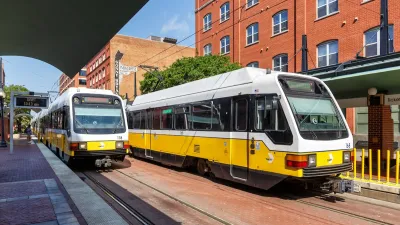Looking at Census data for urbanized areas and auto ownership, Randal O'Toole argues that denser areas have high rates of auto ownership per square mile, a correlation that is likely to increase congestion.
"Among urban areas, the highest auto densities are found in San Francisco-Oakland (4,000 veh/sq mi), San Jose (3,900), and Los Angeles (3,800). The New York-Northern New Jersey urban area only has about 2,200 cars per square mile, but that covers more than 3,300 square miles of land outside of Manhattan, including most of Long Island and parts of New Jersey more than 100 miles south of New York City. The Houston urban area has just 1,700 cars per square mile.
About a dozen incorporated cities and towns have higher auto densities than Manhattan, led by Guttenberg, NJ at 20,600 veh/sq mi and West Hollywood, CA at 13,900 veh/sq mi. Then there is Friendship Village, MD, the highest-density "census-defined place" in America, a small group of high rises housing 82,000 people and 45,000 cars per square mile (though in fact the whole place occupies less than a tenth of a square mile). In general, higher population densities may have lower auto ownership rates but they are still tend to be associated with higher auto densities per square mile. So much for reducing congestion by increasing population densities."
O'Toole's analysis points to relatively low rates of auto ownership in high density areas, but suggests that these areas have disproportionately high concentrations of cars that create the conditions for traffic congestion.
FULL STORY: A Free Parking Space Grows in Manhattan

Alabama: Trump Terminates Settlements for Black Communities Harmed By Raw Sewage
Trump deemed the landmark civil rights agreement “illegal DEI and environmental justice policy.”

Planetizen Federal Action Tracker
A weekly monitor of how Trump’s orders and actions are impacting planners and planning in America.

The 120 Year Old Tiny Home Villages That Sheltered San Francisco’s Earthquake Refugees
More than a century ago, San Francisco mobilized to house thousands of residents displaced by the 1906 earthquake. Could their strategy offer a model for the present?

In Both Crashes and Crime, Public Transportation is Far Safer than Driving
Contrary to popular assumptions, public transportation has far lower crash and crime rates than automobile travel. For safer communities, improve and encourage transit travel.

Report: Zoning Reforms Should Complement Nashville’s Ambitious Transit Plan
Without reform, restrictive zoning codes will limit the impact of the city’s planned transit expansion and could exclude some of the residents who depend on transit the most.

Judge Orders Release of Frozen IRA, IIJA Funding
The decision is a victory for environmental groups who charged that freezing funds for critical infrastructure and disaster response programs caused “real and irreparable harm” to communities.
Urban Design for Planners 1: Software Tools
This six-course series explores essential urban design concepts using open source software and equips planners with the tools they need to participate fully in the urban design process.
Planning for Universal Design
Learn the tools for implementing Universal Design in planning regulations.
Clanton & Associates, Inc.
Jessamine County Fiscal Court
Institute for Housing and Urban Development Studies (IHS)
City of Grandview
Harvard GSD Executive Education
Toledo-Lucas County Plan Commissions
Salt Lake City
NYU Wagner Graduate School of Public Service




























